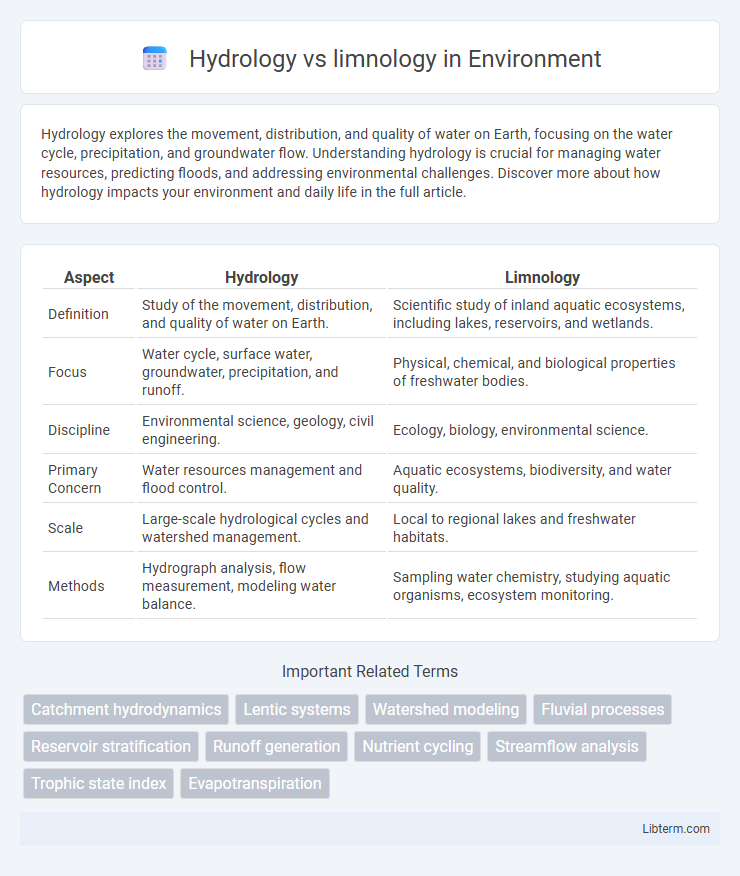Hydrology explores the movement, distribution, and quality of water on Earth, focusing on the water cycle, precipitation, and groundwater flow. Understanding hydrology is crucial for managing water resources, predicting floods, and addressing environmental challenges. Discover more about how hydrology impacts your environment and daily life in the full article.
Table of Comparison
| Aspect | Hydrology | Limnology |
|---|---|---|
| Definition | Study of the movement, distribution, and quality of water on Earth. | Scientific study of inland aquatic ecosystems, including lakes, reservoirs, and wetlands. |
| Focus | Water cycle, surface water, groundwater, precipitation, and runoff. | Physical, chemical, and biological properties of freshwater bodies. |
| Discipline | Environmental science, geology, civil engineering. | Ecology, biology, environmental science. |
| Primary Concern | Water resources management and flood control. | Aquatic ecosystems, biodiversity, and water quality. |
| Scale | Large-scale hydrological cycles and watershed management. | Local to regional lakes and freshwater habitats. |
| Methods | Hydrograph analysis, flow measurement, modeling water balance. | Sampling water chemistry, studying aquatic organisms, ecosystem monitoring. |
Introduction to Hydrology and Limnology
Hydrology studies the movement, distribution, and quality of water on Earth, encompassing surface water, groundwater, and atmospheric water. Limnology specifically examines inland freshwater systems such as lakes, rivers, and wetlands, focusing on their biological, chemical, and physical properties. Both fields integrate hydrological processes but limnology emphasizes aquatic ecosystems and biotic interactions within freshwater environments.
Defining Hydrology: Scope and Applications
Hydrology is the scientific study of the movement, distribution, and quality of water on Earth, encompassing surface water, groundwater, and atmospheric water. Its scope includes analyzing water cycle processes such as precipitation, infiltration, runoff, and evapotranspiration to manage water resources effectively. Applications of hydrology span flood prediction, water supply planning, irrigation management, and environmental protection, distinguishing it from limnology, which specifically focuses on the biological, chemical, and physical properties of inland aquatic ecosystems like lakes and reservoirs.
Understanding Limnology: Focus and Importance
Limnology centers on the study of inland aquatic ecosystems, including lakes, rivers, and wetlands, emphasizing water quality, biological communities, and ecological processes. This discipline is crucial for managing freshwater resources, assessing environmental changes, and supporting biodiversity conservation. Unlike hydrology, which examines the distribution and movement of water on Earth, limnology integrates physical, chemical, and biological data to understand aquatic ecosystem dynamics.
Key Differences Between Hydrology and Limnology
Hydrology primarily studies the distribution, movement, and quality of water in the Earth's atmosphere, surface, and underground, while limnology focuses specifically on inland freshwater ecosystems such as lakes, rivers, and wetlands. Key differences include hydrology's emphasis on water cycle processes like precipitation, runoff, infiltration, and groundwater flow, whereas limnology examines biological, chemical, and physical interactions within freshwater habitats. Hydrology integrates large-scale water resource management, whereas limnology contributes to understanding freshwater biodiversity, ecology, and ecosystem health.
Core Concepts in Hydrological Studies
Hydrology primarily focuses on the distribution, movement, and quality of water in the Earth's atmosphere, surface, and subsurface, emphasizing the water cycle's processes such as precipitation, infiltration, evaporation, and runoff. Limnology, a sub-discipline of hydrology, concentrates specifically on inland aquatic ecosystems like lakes, rivers, and wetlands, studying their biological, chemical, and physical properties. Core concepts in hydrological studies include watershed management, groundwater flow, surface water interactions, and hydrological modeling, which are essential for water resource management and environmental sustainability.
Fundamental Principles of Limnological Research
Limnology focuses on the study of inland aquatic ecosystems, emphasizing the physical, chemical, and biological properties of freshwater bodies, while hydrology broadly examines the movement, distribution, and quality of water throughout the Earth's surface. Fundamental principles of limnological research include analyzing nutrient cycling, thermal stratification, and primary productivity within lakes and reservoirs to understand ecosystem dynamics. These principles underpin assessments of water quality, aquatic biodiversity, and the effects of environmental changes on freshwater habitats.
Tools and Techniques in Hydrology vs Limnology
Hydrology employs tools like rain gauges, streamflow meters, and remote sensing technologies for measuring precipitation, water flow, and watershed dynamics, while limnology utilizes multiparameter probes, sediment corers, and plankton nets to analyze the chemical, physical, and biological properties of inland water bodies. Hydrological techniques often involve watershed modeling, hydrograph analysis, and groundwater monitoring, whereas limnological methods emphasize water quality testing, ecological assessments, and nutrient cycling studies. Both disciplines integrate GIS and data loggers for spatial-temporal analysis but target different aquatic environments--watersheds in hydrology and lakes or reservoirs in limnology.
Interdisciplinary Connections and Overlaps
Hydrology and limnology intersect significantly through their shared focus on water systems and aquatic environments, with hydrology concentrating on the movement and distribution of water in the hydrological cycle, while limnology specializes in the study of inland freshwater ecosystems such as lakes, rivers, and wetlands. Both disciplines utilize overlapping methods in water quality assessment, ecosystem health evaluation, and biogeochemical cycling, fostering collaboration in addressing climate change impacts, water resource management, and habitat conservation. Research integrating hydrological models and limnological data enhances understanding of watershed dynamics, sediment transport, and nutrient fluxes critical for sustainable environmental planning.
Career Paths in Hydrology and Limnology
Hydrology career paths include roles such as water resource manager, hydrologist, and environmental consultant focused on water cycle analysis, watershed management, and flood prediction. Limnology professionals pursue careers as aquatic ecologists, freshwater biologists, or water quality specialists studying inland water bodies like lakes, rivers, and wetlands. Both fields offer opportunities in research, environmental protection agencies, and sustainability projects centered on water system management and conservation.
Future Trends and Challenges in Water Sciences
Hydrology and limnology increasingly integrate advanced remote sensing and machine learning technologies to enhance water resource management and aquatic ecosystem understanding. Future trends emphasize climate change impacts, necessitating adaptive modeling for predicting hydrological cycles and freshwater ecosystem responses. Challenges include data scarcity in developing regions and the need for interdisciplinary approaches to address water quality, availability, and biodiversity conservation effectively.
Hydrology Infographic

 libterm.com
libterm.com